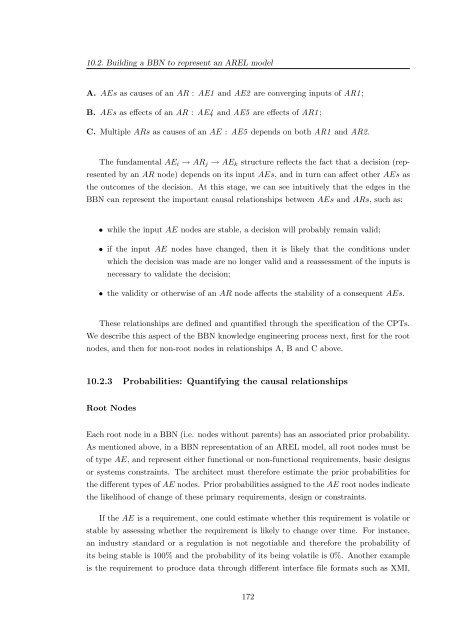A Rationale-based Model for Architecture Design Reasoning
A Rationale-based Model for Architecture Design Reasoning
A Rationale-based Model for Architecture Design Reasoning
You also want an ePaper? Increase the reach of your titles
YUMPU automatically turns print PDFs into web optimized ePapers that Google loves.
10.2. Building a BBN to represent an AREL model<br />
A. AEs as causes of an AR : AE1 and AE2 are converging inputs of AR1 ;<br />
B. AEs as effects of an AR : AE4 and AE5 are effects of AR1 ;<br />
C. Multiple ARs as causes of an AE : AE5 depends on both AR1 and AR2.<br />
The fundamental AE i → AR j → AE k structure reflects the fact that a decision (represented<br />
by an AR node) depends on its input AEs, and in turn can affect other AEs as<br />
the outcomes of the decision. At this stage, we can see intuitively that the edges in the<br />
BBN can represent the important causal relationships between AEs and ARs, such as:<br />
• while the input AE nodes are stable, a decision will probably remain valid;<br />
• if the input AE nodes have changed, then it is likely that the conditions under<br />
which the decision was made are no longer valid and a reassessment of the inputs is<br />
necessary to validate the decision;<br />
• the validity or otherwise of an AR node affects the stability of a consequent AEs.<br />
These relationships are defined and quantified through the specification of the CPTs.<br />
We describe this aspect of the BBN knowledge engineering process next, first <strong>for</strong> the root<br />
nodes, and then <strong>for</strong> non-root nodes in relationships A, B and C above.<br />
10.2.3 Probabilities: Quantifying the causal relationships<br />
Root Nodes<br />
Each root node in a BBN (i.e. nodes without parents) has an associated prior probability.<br />
As mentioned above, in a BBN representation of an AREL model, all root nodes must be<br />
of type AE, and represent either functional or non-functional requirements, basic designs<br />
or systems constraints. The architect must there<strong>for</strong>e estimate the prior probabilities <strong>for</strong><br />
the different types of AE nodes. Prior probabilities assigned to the AE root nodes indicate<br />
the likelihood of change of these primary requirements, design or constraints.<br />
If the AE is a requirement, one could estimate whether this requirement is volatile or<br />
stable by assessing whether the requirement is likely to change over time. For instance,<br />
an industry standard or a regulation is not negotiable and there<strong>for</strong>e the probability of<br />
its being stable is 100% and the probability of its being volatile is 0%. Another example<br />
is the requirement to produce data through different interface file <strong>for</strong>mats such as XMI,<br />
172
















